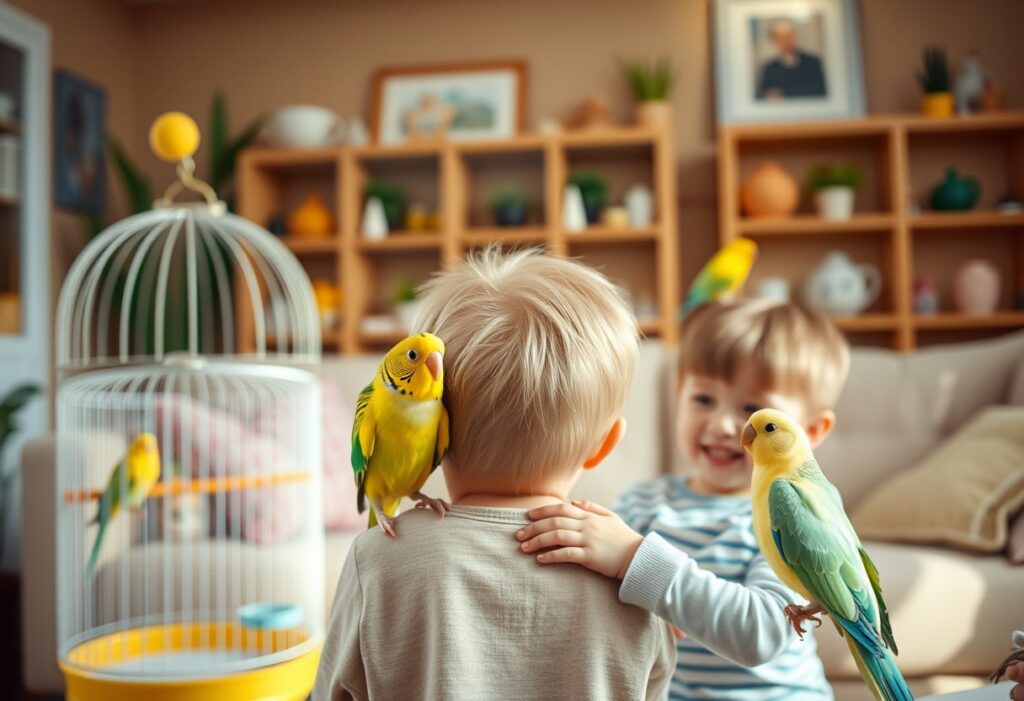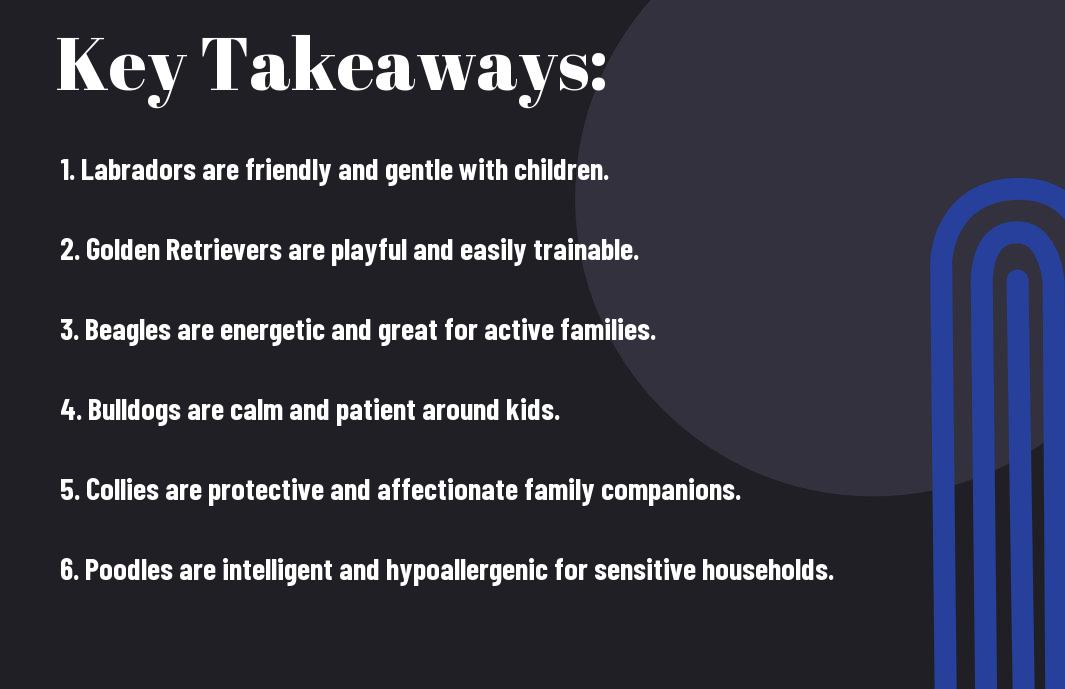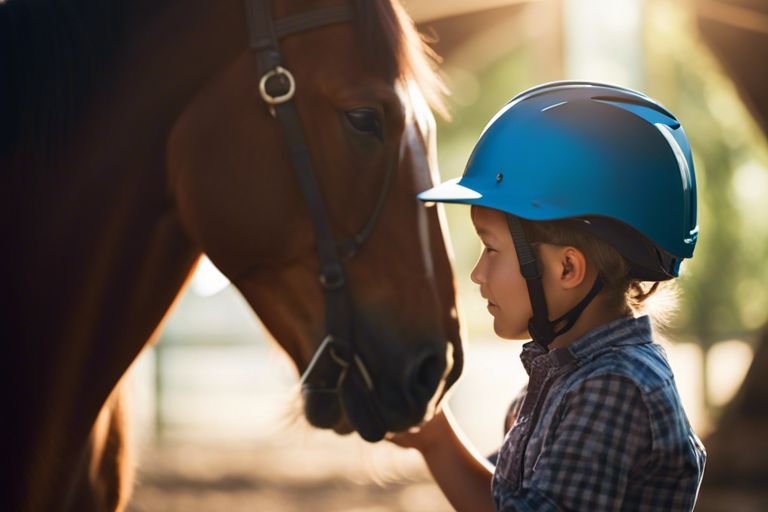Families looking to bring a feathered friend into their home will find that not all bird breeds are suitable for children. It’s necessary to choose pets that are gentle, social, and resilient to ensure a harmonious environment for both your kids and the birds. In this informative post, you will discover the top bird breeds that are not only enjoyable companions but also safe for young ones, helping you create lasting memories while educating your children about responsibility and animal care.
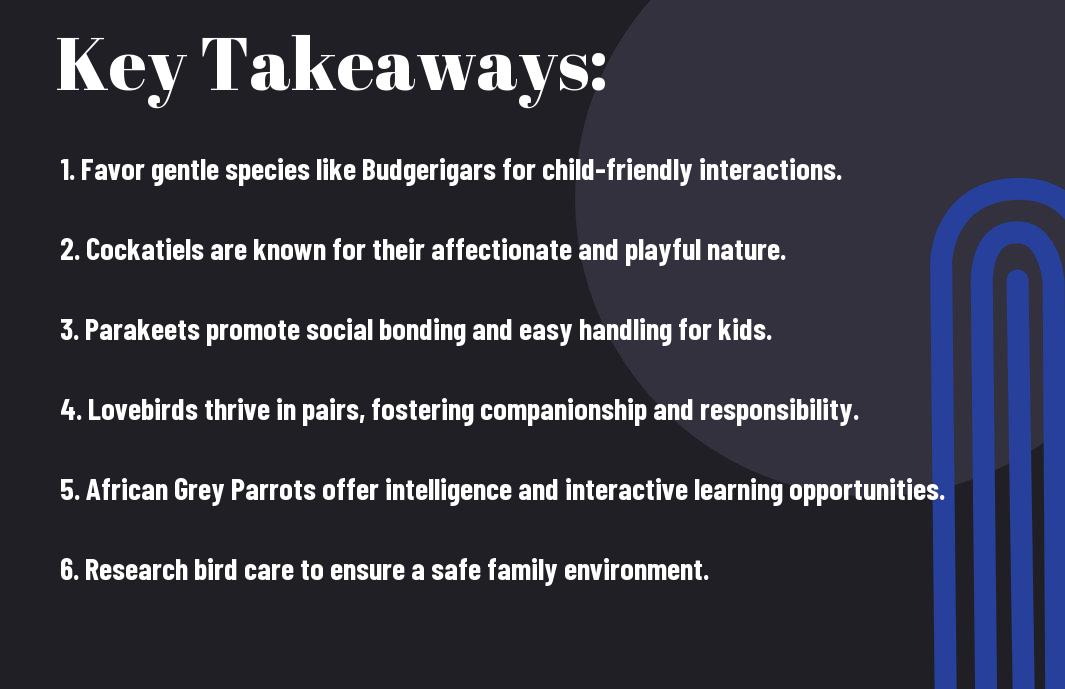
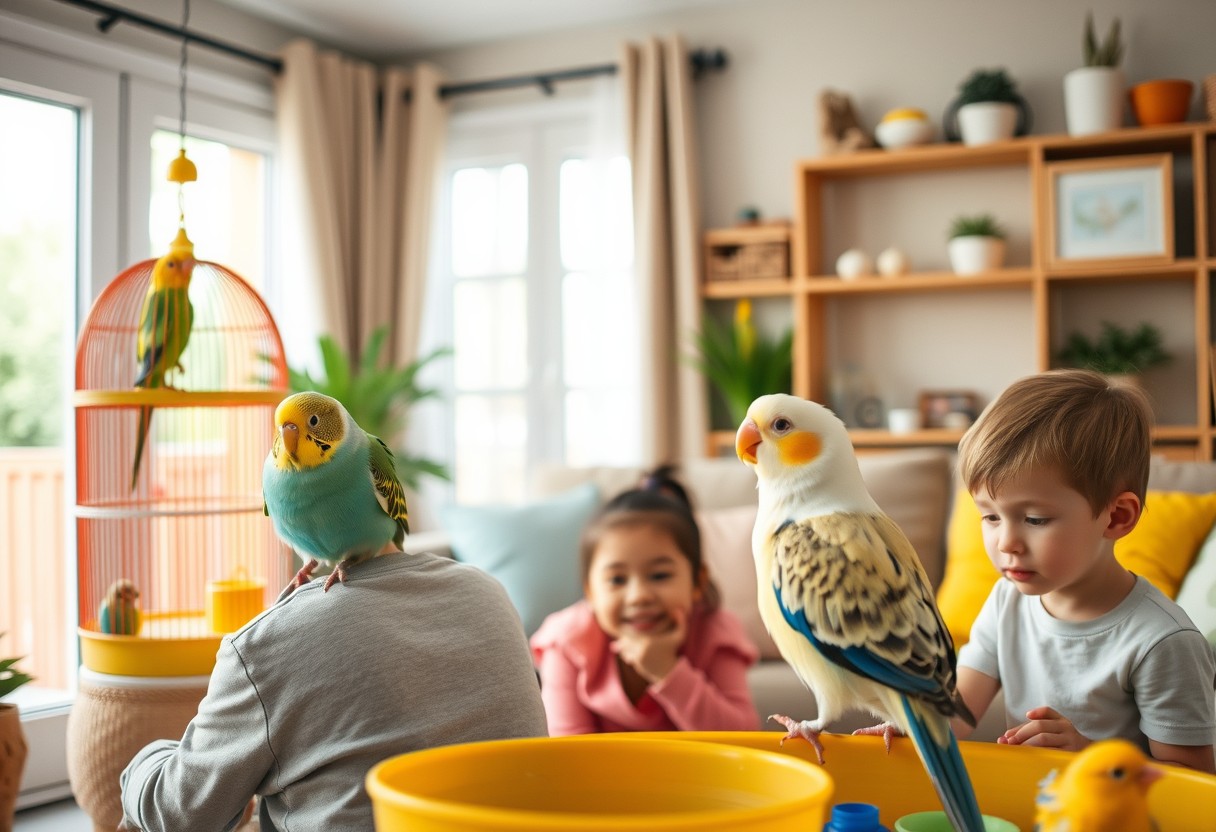
Understanding Family-Friendly Bird Breeds
A crucial step in integrating birds into your household is understanding which breeds are deemed family-friendly. When considering a pet bird for your family, you want to choose breeds that possess the right characteristics to ensure a harmonious relationship with your children. Family-friendly birds are typically known for their gentle temperament, social nature, and ability to tolerate the hustle and bustle of family life without becoming overly stressed. These birds often enjoy engaging with their human companions, making them a great choice for families.
Characteristics of Family-Friendly Birds
Breeds such as budgerigars, cockatiels, and lovebirds are known for their affectionate personalities and compatibility with children. They often display playful behaviors, which can capture the attention of little ones, enriching the family experience. Moreover, family-friendly birds tend to >be eager learners, readily picking up tricks and sounds, which can further strengthen the bond between your children and their feathered friends. Additionally, these birds usually don’t require extensive space, making them suitable for various living situations.
Benefits of Having Birds in a Family Setting
Benefits of having birds in a family setting extend beyond mere companionship. Introducing a pet bird into your home can teach your children important life skills such as nurturing and responsibility. Caring for a feathered friend requires daily duties, including feeding, cleaning, and social interaction, promoting teamwork and empathy as your kids learn to respect another living being’s needs.
For instance, maintaining the health of your bird can lead to discussions about animal welfare, the importance of nutrition, and the value of regular veterinary check-ups. This experience enhances your children’s understanding of responsibility and can foster a love for animals that lasts a lifetime. Additionally, birds can bring joy and laughter into your home, providing delightful companionship that enriches your family’s daily life.
Top Bird Breeds for Families
It is vital to choose the right bird breed when you have children at home. The ideal pet should be safe, friendly, and able to engage positively with your family. Throughout this guide, you’ll discover some exceptional bird breeds that are particularly suited for family environments, enhancing your home through companionship and interaction.
Budgerigar (Budgie)
One of the most popular choices for families is the Budgerigar, commonly known as the “budgie.” These small, colorful parrots are not only charming but also make great companions for children. Budgies are known for their friendly personalities and can easily be trained to interact with people, which makes them an excellent choice for encouraging responsibility in kids. Their cheerful chirping and playful nature provide hours of entertainment.
Furthermore, budgies are relatively easy to care for and don’t require extensive space, which makes them ideal for families living in smaller homes. They thrive on social interaction, so your kids can bond with them while learning about proper pet care. With proper handling and care, budgies often become loving and entertaining family members.
Cockatiel
To introduce a bird that is slightly larger yet equally affectionate, consider the Cockatiel. These birds are known for their gentle temperament and striking crest. Cockatiels are excellent with children, often displaying playful and curious behavior that encourages interaction. They are also known to whistle tunes and mimic sounds, bringing additional joy to your household.
It is important to note that cockatiels require socialization and mental stimulation to thrive; engaging your kids in their care can help develop a nurturing bond. They enjoy spending time out of their cage and can often be seen playfully interacting with your family members. Their calm disposition and affectionate nature make them a fantastic option for families.
Conure
To add a splash of color and vivacity to your family, the Conure is an excellent choice. These birds are known for their playful and social personality, making them wonderful companions for active households. Conures come in various species, each with unique colors and characteristics, appealing to different tastes and preferences. They thrive in a sociable environment, and your children will enjoy the lively, energetic nature that these birds bring.
It is important to keep in mind that conures can be vocal and may require sufficient interaction, so ensuring your children understand their needs is key. With regular interaction, conures become very attached to their families, displaying affectionate behaviors that can strengthen family bonds.
Lovebird
On the lookout for a small, affectionate bird? Your family might fall in love with a Lovebird. These little parrots are known for their strong pair bonds and sociable nature, making them a delightful addition to your home. Lovebirds generally enjoy interacting with their human companions and thrive on the attention they receive, making them perfect for families looking for engaging pets.
Another positive aspect of lovebirds is their playful demeanor; they love to play with toys and engage in interactive games. However, it’s crucial to supervise young children when handling lovebirds to ensure a safe and positive experience for both the pet and your child. With proper care and socialization, lovebirds can become deeply bonded with family members.
African Grey Parrot
Breeds like the African Grey Parrot are often regarded as one of the most intelligent pet birds available. These birds are known for their remarkable cognitive abilities and can even develop extensive vocabularies. Though they require more care than smaller bird breeds, their engaging personalities and ability to mimic human speech make them rewarding pets for families dedicated to providing time and attention.
This breed thrives in environments where they feel mentally stimulated and loved. Therefore, it is important to ensure your children understand the commitment involved in caring for an African Grey. When they receive sufficient attention and enrichment, these parrots can form strong emotional bonds with your family, making them not just companions but also true members of your household.
Care and Maintenance of Family Birds
Keep in mind that proper care and maintenance of family birds is crucial for their health and happiness. These lovely creatures require a stable and enriching environment that accommodates their natural behaviors and needs. Investing time in understanding their habitat and space requirements will not only ensure they thrive but also foster strong bonds within your family.
Habitat and Space Requirements
Any bird you choose will need a spacious and safe living area. Depending on the breed, you should provide an appropriately sized cage with enough room for them to spread their wings. As a general rule, larger birds like parrots require bigger cages, while smaller breeds like budgerigars can be comfortably housed in something more compact. Additionally, consider placing the cage in a common area of your home where your family frequently gathers, as this will enhance the bird’s socialization.
To ensure a healthy habitat, you should also include perches at different heights, toys for mental stimulation, and regular access to fresh air outside the cage for safe playtime. The environment should be both clean and safe, free from drafts and direct sunlight that might overheat your feathered friends. Accessories such as food and water dishes should be placed within easy reach, and it’s vital to maintain a routine for cleaning to prevent the buildup of bacteria.
Diet and Nutrition
Care for your birds’ diet and nutrition is vital for their long-term health. Different bird species have specific dietary needs, but in general, a balanced diet consists of high-quality pellets, fresh fruits, vegetables, and occasional treats such as seeds. It’s crucial to avoid feeding your birds toxic foods like avocado, chocolate, and caffeine, as these can seriously harm their health.
This balanced diet will help ensure that your birds receive the necessary vitamins and minerals to thrive. Regularly introducing a variety of foods can also stimulate their interest and appetite. Make sure to consult with a vet who specializes in avian care to tailor a diet that meets your bird’s unique needs and monitor their weight to prevent obesity.
Interaction and Socialization
An important aspect of caring for family birds is ensuring they receive ample interaction and socialization. Birds are social creatures and will benefit from regular human interaction, which helps prevent behavioral issues such as anxiety or self-destructive habits. Schedule playtime out of the cage, allowing your birds to explore, interact with family members, and engage in play to develop their social skills.
This kind of interaction not only helps them feel secure and loved but also promotes better mental health. Engaging with your birds regularly can create a strong bond that enriches their lives and enhances your family’s experience with them. As your birds become more accustomed to your presence, they may even learn tricks and mimic sounds, becoming delightful companions.
Maintenance of your birds involves regular cleaning and health checks to ensure they remain in good condition. Be vigilant about monitor your birds for signs of illness, such as changes in appetite, abnormal droppings, or lethargy, and seek veterinary care promptly if you notice anything concerning. By prioritizing their care and maintenance, you will foster a happy, healthy, and strong bond between your family and your feathered members.
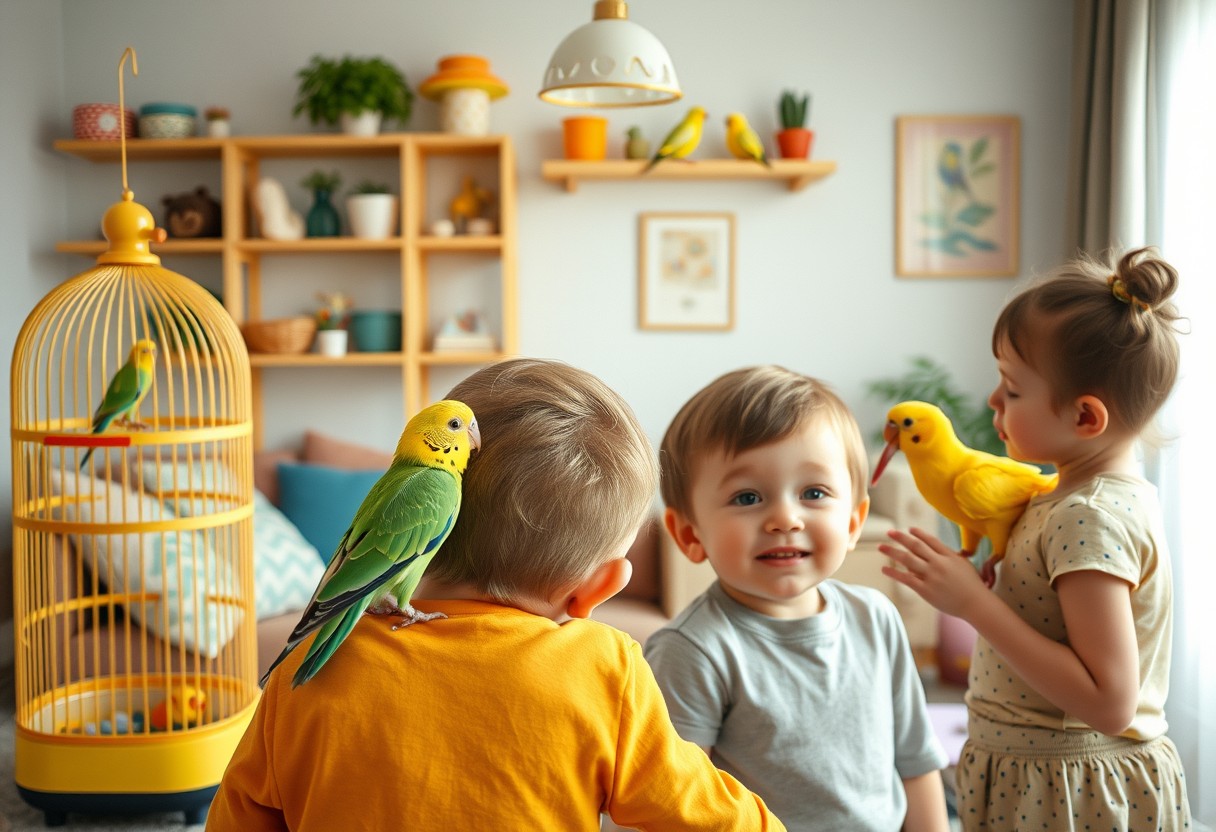
Safety Considerations for Children and Birds
All families considering a pet bird should prioritize safety, particularly when young children are involved. Birds are delicate creatures that require a specific environment and gentle handling. To ensure a harmonious relationship between your children and your feathered friends, it’s crucial to establish guidelines and educate everyone on how to interact safely with these beautiful pets.
Teaching Children Bird Safety
The first step in fostering a safe environment for both your children and birds is teaching your children the principles of bird safety. Explain to them that birds are not toys; rather, they are living beings that can be easily injured. Encourage your children to gently approach the bird, use calm voices, and avoid loud sounds that could startle them. They should understand the importance of letting the bird come to them, rather than forcing interaction.
It’s also vital to teach your children to recognize signs of stress or fear in birds. Understanding body language—such as puffing up feathers, retreating, or biting—is critical. This awareness will cultivate compassion and protect both your child and the bird from potential harm.
Supervision Guidelines
Guidelines for supervision are vital to ensure safety during interactions. Always supervise your children when they are engaging with the bird, especially during the initial stages of introduction. Make it a rule that young children cannot handle the bird without adult assistance or permission. This practice not only protects the bird but also teaches children the significance of responsibility and respect for pets.
Furthermore, establish clear areas where the bird can fly freely, and where children can play safely. This ensures that your bird has a sense of security, and your kids can enjoy their playful moments without the risk of accidental harm.
Another key factor in supervision is to create an environment that limits opportunities for accidents. This might include removing any sharp objects, and placing the bird’s cage or play area out of reach of overzealous hands. Ensuring that children understand and follow these guidelines will go a long way in maintaining a safe atmosphere for everyone.
Creating a Safe Environment
Bird safety goes beyond just interactions; it also involves creating a safe environment for your pets. Make sure the living area is bird-proofed, which means removing any potentially harmful items such as toxic plants, small objects that can be swallowed, or anything that could lead to accidents like open windows. By establishing this safe haven, you protect your pet while teaching your children the importance of their surroundings.
For instance, consider investing in safe toys specifically designed for birds. These alternatives can provide entertainment and fulfill their instinctual needs without exposing your feathered friends to objects that may be hazardous. Additionally, ensure your birds have access to proper housing that is well-ventilated and spacious enough to avoid stress. This proactive approach fosters a safe and enjoyable atmosphere for both your children and your winged companions.
Summing up
The best bird breeds for families with children are those that not only possess gentle temperaments but also thrive in an interactive environment. As a potential bird owner, you should consider breeds such as Budgerigars, Cockatiels, and Lovebirds, which are known for their sociable nature and ability to bond with family members. These birds often enjoy playful interactions, and their vibrant personalities can add a lively dynamic to your household. Moreover, their relatively manageable sizes make them suitable for families with young kids, helping to cultivate responsibility and compassion in your children through pet care.
Additionally, it’s vital to establish a safe space where your feathered companions can feel secure while interacting with your children. Educating your kids on how to approach, handle, and respect birds will only enhance the experience for everyone involved. Your choice of bird breed can significantly influence the harmony in your home, ensuring that both your family and your new pet will enjoy a fulfilling companionship. By carefully choosing the right breed and fostering a nurturing environment, you can create lasting memories and teach your children valuable lessons about empathy and responsibility through the joy of avian companionship.
FAQ
Q: What are some of the best bird breeds for families with young children?
A: Some of the best bird breeds for families with young children include Budgerigars (Budgies), Cockatiels, and Lovebirds. Budgies are small, friendly, and relatively easy to care for, making them great companions for kids. Cockatiels are known for their playful nature and can be easily trained to do tricks. Lovebirds are social and affectionate, which can help children learn about responsibility and empathy towards pets.
Q: Are there any bird breeds that are particularly safe for children to handle?
A: Yes, certain bird breeds are generally safer for children to handle. Budgerigars and parakeets are known for their gentle demeanor and lightweight bodies, making them easier for children to manage. Cockatiels are also known for their calm nature and are usually safe to handle with supervision. However, it’s important to teach children proper handling techniques and always supervise interactions to ensure the bird feels safe and secure.
Q: How can families prepare their homes for a pet bird to ensure the safety of both children and the bird?
A: To prepare your home for a pet bird, start by creating a safe environment by removing any hazards such as open windows, toxic plants, and small objects that the bird could swallow. Ensure that the bird’s cage is placed in a area that’s away from high-traffic areas to prevent accidents. Teach children appropriate behavior around birds, including how to approach gently and respect the bird’s space.Overall, consistent supervision and education about bird care can foster a harmonious relationship between your children and their avian companion.
